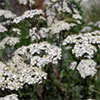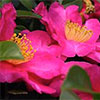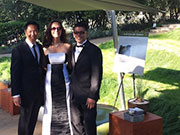 |
||||||||||||||
|
||||||||||||||
Monthly Archives: April 2014
Camellias vs. Carpenteria
Blooms Beneath the Dappled Light of Oak Canopies
The dappled light of California native Live Oak canopies gives our local woodland gardens a distinctive zen like serenity. This zen mindset must be harnessed to find under-canopy foliage that can thrive in an oak grove! Camellias and Carpeteria californica both happily light up shady areas with big blooms and glossy green leaves on an attractive architectural structure, but which one will keep your oaks happy?

Lush, leafy, low-water Bush Anemone (Carpenteria californica) substitutes for camellias. They thrive through even the hottest and driest of LA summers.
Camelias are a common under-canopy choice plant in Los Angeles. Their deep green, incredibly glossy, foliage emanates from a particularly attractive branching structure. The architectural balance of branches and leaves erupt with large but delicate flowers ranging from red and pink, to white. With the right selection of hybrids (there are hundreds!) a firework finale of blooms will enliven woodland gardens from January through end of March. What could be better? Sometimes it’s hard to see the forest through the Camellias, but in our dry summer climate, Camellias do have a few drawbacks. Camelias:
- Demand quite a bit of supplemental water through the summer
- Crave even more water through a dry winter, like this one
- Perform poorly in our typically alkaline soils and like supplements to keep their soils acid
While water and fertilizer may be a cost you are willing to bear for outrageous blooms, they have unique consequences in an oak grove. Summer water and fertilizer under an oak is potentially lethal and definitively destructive to Oak health. Ironically, not only the oaks suffer. Extra summer watering can promote Armilaria, bringing root rot to the Camelias themselves as well as the oaks.
A true ringer for Camellia, Bush Anemone burst into a flurry of white Peony-like blooms this time of year. Typically four to six foot tall and three to four foot wide, Bush Anemone under cultivation, like the widely-available “Elizabeth,” may have much more compact foliage and particularly large blooms. Bush Anemone:
- Survives a wide range of climates and soils, as is native to dry slopes, ridges and Pine forests throughout California
- Thrives in woodland gardens and under oaks
- Loves pruning and can be formed to produce fuller growth
- Resists drought in the shade… although in full sun it should get a few sips of water a month (take care to provide these sips at the root, as overhead irrigation can lead to leaf spot)
Compliment the Bush Anemone in the woodland garden or under oaks with Woodwardia frimbriata, Heuchera maxima, Thalictrum fendleri (Meadow Rue), Aquilegia formosa, Adiantum jordanii (Maidenhair Fern), Ribes viburnifolium and Ribes malvaceum (Chaparral Current).
Wildland to Urban Garden (2/2)
- Lilac Verbena, Verbena lilacina
Bringing the Wild to Urban Spaces
Last month, we noted how introducing the wonders of nature back into our every-day habitats replenishes our clarity of thought and our emotional balance. Nowhere is this more important than in our urban spaces. While urban properties pose distinctive design challenges, it is still possible and beneficial to take nature’s lead in design.
The expansive Weiss-Lindberg garden in well-trafficked, commercial midtown Santa Monica proves that restorative natural habitat can thrive in urban environments. The family aimed to draw birds, butterflies, and beneficial insects to the property. This meant using foliage adapted to the area’s coastal climate in the hopes of attracting more life into a seemingly humans-only habitat.
In the garden, native plants provide homes for flying friends and other fauna while delivering delightful bursts of seasonal color consistent with a thriving coastal prairie. A particularly powerful coastal companion combination includes:
- Asclepias, habitat for butterfly larvae with Verbena lilacaena, with pollen for mama butterflies,
- Lupinus albifrons, Salvia spathacae (Hummingbird Sage), and Sisyrinchium californicum, which provide haven for hummingbirds and a riot of texture and color throughout various times of the year, and
- Yarrow meadow, an IdealMow lawn alternative adapted to coastal environments.
Together, this mix creates a safe harbor for wild things, attracting them through the city streets into a midtown oasis. Each thrives in the cool year round temperatures and wind, fog and dew expected along the coast. In nature, most of this pallet tolerates poor drainage, some boggy areas, low nutrient and even sandy soils, making it a wonderful option for coastal urban environments. To maximize the health of the natives and minimize water use, raised garden beds house edibles for humans that demand more water and higher soil quality.
While native habitat and a succulent food supply are great draws, no oasis is complete without water. A charming, delicate pond boosts the bird and butterfly attracting potential of the property while adding an air of whimsy to delight its humans.
 Gallery: Los Angeles Times. Anne Colby explores a LEED® property in Rustic Canyon. As playful as it looks, from the carefully shaded water features to the rainchain-fed infiltration pit, this garden is a water-saving powerhouse.
Gallery: Los Angeles Times. Anne Colby explores a LEED® property in Rustic Canyon. As playful as it looks, from the carefully shaded water features to the rainchain-fed infiltration pit, this garden is a water-saving powerhouse.  Tips: Copying nature’s designs is a no brainer for homes with a wildland interface, but what about properties that are decidedly urban? Here the benefits may be even more profound! See examples of how we designed from nature at the Weiss-Lindberg garden, in mid-own Santa Monica, one of our two 2014 Theodore Payne Foundation Native Garden Tour homes.
Tips: Copying nature’s designs is a no brainer for homes with a wildland interface, but what about properties that are decidedly urban? Here the benefits may be even more profound! See examples of how we designed from nature at the Weiss-Lindberg garden, in mid-own Santa Monica, one of our two 2014 Theodore Payne Foundation Native Garden Tour homes.  Wet-to-Dry: April showers bring May flowers, but what happens when no one turns on the spigot? Exchanging Carpenteria californica for Camellias will bring blooms to your garden in May, come what may in April.
Wet-to-Dry: April showers bring May flowers, but what happens when no one turns on the spigot? Exchanging Carpenteria californica for Camellias will bring blooms to your garden in May, come what may in April. 





